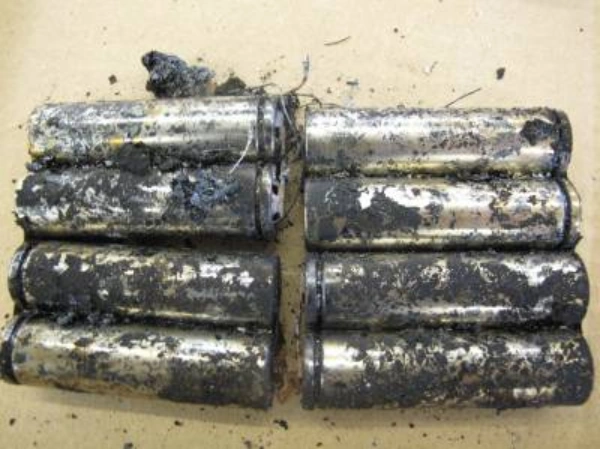Lithium battery failure refers to a state in which a lithium-ion battery cannot maintain its design performance or reach its expected life for various reasons. This type of failure may manifest itself in performance failures such as capacity decline, increased internal resistance, slowed charging speed, shortened cycle life, poor consistency, easy self-discharge, and safety risks such as thermal runaway, gas, electrolyte leakage, lithium precipitation, short circuit, expansion deformation, etc.
Part 1. Reasons for lithium battery failure
1. Number of charging cycles
The life of a lithium-ion battery is related to the number of charging cycles. After a certain number of times, the battery capacity will decrease, leading to failure.
2. Overcharge and over-discharge
Overcharging or over-discharging for a long time can cause chemical changes inside the battery and reduce battery performance.
3. High temperature environment
High temperatures will accelerate chemical reactions in the battery, causing battery aging and resulting in reduced performance.
4. Physical damage
Physical damage to the battery, such as impact or extrusion, may cause internal short circuit or damage, failing.
Part 2. Principle of lithium battery failure
1. Lithium-ion migration
Lithium ions migrate between the positive and negative electrodes during the charge and discharge cycle. However, this migration process will cause structural changes in the electrode material and reduce battery performance.
2. Electrolyte degradation
The degradation of the electrolyte will cause unstable chemical reactions inside the battery and affect the battery’s cycle life.
3. Formation of solid electrolyte interface (SEI film)
Lithium-ion batteries form a solid electrolyte interface during charge and discharge cycles. As the number of cycles increases, the continued formation of this interface will lead to increased resistance and reduced battery performance.
Part 3. Battery failure mode
The failure modes of battery systems are mainly capacity fading, internal resistance increase, and polarization. According to the structure and composition of the battery system, it can be divided into three different failure modes. These are battery cell failure mode, battery management system failure mode, and Pack system integration failure mode.
1. Battery core failure mode
The failure modes of battery cells can be divided into safety failure modes and non-safety failure modes. The main reasons for battery core safety failure are as follows:
a. The positive and negative poles of the battery cell are short-circuited inside.
Due to defects in the battery cell production process or long-term vibration external force, the cell deforms, eventually causing a short circuit within the battery. Once a severe internal short circuit occurs, the control cannot be stopped, and the external insurance does not work; smoke or burning will occur.
b. battery cell leakage
External force damage, collision, improper installation causing damage to the sealing structure, welding defects, insufficient sealing glue resulting in poor sealing performance, etc., may lead to battery leakage. After the battery leaks, the insulation of the entire battery pack fails. An external short circuit will occur when there are many insulation failure points.
c. Lithium precipitation from the negative electrode of the battery
Improper use of the battery, overcharging, low-temperature charging, and high-current charging will cause lithium deposition in the battery’s negative electrode. After lithium precipitation occurs in the negative electrode, lithium metal cannot be reduced, resulting in an irreversible decline in battery capacity. Lithium precipitation reaches a certain level, forming lithium dendrites, which pierce the diaphragm and cause an internal short circuit. Therefore, power batteries should be strictly prohibited from being charged at low temperatures.
d. The battery cell is bloated and bulging.
There are many reasons for battery bloating. Side reactions inside the battery produce gas, which can cause battery bloating. The problem of flatulence can be avoided by strictly controlling moisture during the battery cell production process. Once battery bloating occurs, leakage and other situations may occur.
The battery cell has a greater risk of security failure. In contrast, non-safety failures only cause performance problems such as poor temperature consistency, excessive self-discharge, reduced low-temperature discharge capacity, and battery capacity attenuation.
2. BMS failure mode
a. BMS voltage detection failure causes battery overcharge or over-discharge
The voltage detection line fails due to poor connection, crimping process, or contact. The BMS has no voltage information and does not stop when charging. Overcharged batteries can catch fire or explode. Most lithium iron phosphate batteries that are overcharged above 5V just smoke, but once the ternary battery is overcharged, it will explode.
Moreover, overcharging can easily cause the electrolyte in lithium-ion batteries to decompose and release gas. This will cause the battery to bulge or even smoke and catch fire in severe cases. Over-discharge of the battery will cause damage to the molecular structure of the battery’s positive electrode material, resulting in an inability to charge. At the same time, the battery voltage is too low, causing the electrolyte to decompose and dry out, causing lithium precipitation and short circuit problems in the battery.
Reliable voltage collection lines should be selected during system design and strictly controlled during the production process to prevent voltage collection line failure.
b. BMS current detection failure
The Hall sensor fails, the BMS cannot collect current, the SOC cannot be calculated, and the deviation is large. Failure of current detection may result in excessive charging current. The charging current is large, the internal heat of the battery cell is large, and the temperature exceeds a certain temperature, which will cause the curing capacity of the separator to decay. This will seriously affect the battery life.
c. BMS temperature detection failure
Temperature detection failure causes the battery operating temperature to be too high, causing the battery to undergo irreversible reactions, which greatly impacts battery capacity and internal resistance. The calendar life of the battery cell is directly related to the temperature. The number of cycles at 45°C is half that at 25°C. In addition, the battery is prone to bulging, leakage, explosion, and other problems if the temperature is too high. Therefore, the temperature of the battery must be strictly controlled during battery use. Between 20-45℃, in addition to effectively improving the service life and reliability of the battery, it can also effectively avoid short circuits and high-temperature thermal runaway caused by lithium deposition during low-temperature charging of the battery.
d. Insulation monitoring failure
Insulation failure will occur when the power battery system is deformed or leaks. If the BMS is not detected, an electric shock may occur. Therefore, the BMS system should have the highest requirements for monitoring sensors. Avoiding monitoring system failure can greatly improve the safety of power batteries.
e. Communication failure due to electromagnetic compatibility issues
For the BMS system, electromagnetic compatibility mainly assesses its ability to resist electromagnetic interference. Electromagnetic interference will cause BMS communication failure and cause the above problems.
f. Large deviation in SOC estimation
There are currently widespread biases in BMS. General inspection standards require that the deviation be within 5%. Most battery manufacturers’ BMS should find it difficult to achieve this. Due to the complexity of the use environment, the SOC error will become larger and larger in actual use.
3. pack system integration failure mode
a. Bus failure
If it is a bolted connection, during later use, the bolts will oxidize and fall off, or the bolts will become loose due to vibration, which will cause a large amount of heat to be generated at the conductor connection. In extreme cases, the power battery may catch fire.
b. The main circuit connector of the power battery system fails.
The high-voltage line of the power battery system is connected to the external high-voltage system through a connector. The connector’s performance is unreliable, and virtual connections occur under vibration, resulting in high-temperature ablation of the connector. Generally speaking, connection failure will occur when the connector temperature exceeds 90 degrees. Therefore, during system design, the connector needs to add a high-voltage interlock function or attach a temperature sensor to the connector to monitor the temperature of the connector at all times to prevent connector failure.
c. High voltage contactor is sticky
The contractor has a certain number of load openings. Most contactors are ablated when the large current load is closed. A dual relay scheme is generally adopted in the system design, and the closing control is performed in sequence to prevent the high-voltage contactor from sticking.
d. Fuse overcurrent protection fails
Sizing and matching of fuses in high-voltage system components. Which gradient should be broken first and which should be broken later needs to be considered comprehensively. Vibration or external collision and extrusion cause the power battery to deform, the seal to fail, and the IP rating is reduced. Therefore, the collision protection of the battery box structure needs to be considered during system design.
Part 4. How to prevent lithium battery failure
1. Proper charging and discharging
Avoid overcharging and discharging lithium batteries. Use appropriate charging and discharging strategies to delay battery aging.
2. Control the temperature
Avoid exposing lithium batteries to high temperatures to slow down battery aging.
3. Use a battery management system (BMS)
BMS can monitor the status of lithium batteries, detect problems in advance, and take measures to protect batteries from overcharge and over-discharge.
4. Regular maintenance
Check battery status regularly, clean battery connectors, ensure adequate ventilation and prevent physical damage.
Part 5. Summary
The failure of lithium batteries is due to some specific essential reasons that lead to battery performance degradation or abnormal performance. Lithium battery failure is divided into performance failure and safety failure.
Lithium-ion batteries may experience certain failures during production, transportation, and use. Moreover, the failure of a single battery will affect the performance and reliability of the entire lithium battery pack. It may even cause the battery pack to stop working or other safety issues.
Related Tags:
More Articles

How to Choose the Best Floor Scrubber Battery for Commercial Cleaning?
Selecting the ideal floor scrubber battery ensures a long runtime, rapid charging, and minimal maintenance for efficient commercial cleaning operations.
Battery for Blower vs Battery for Leaf Vacuum: Which One Should You Choose?
Battery for blower vs leaf vacuum—learn the key differences in power, fit, and runtime to choose the right battery for your outdoor tool needs.
How to Choose the Right Battery for Blower?
Choosing the right blower battery? Consider voltage, capacity, chemistry & usage. This guide helps match the best battery for peak performance.
How to Choose the Best Insulated Battery Box for Lithium Batteries?
Choosing the Best Insulated Battery Box for Lithium Batteries? Discover key factors such as size, material, and safety for optimal protection and performance.
7 Critical Elements on a Lithium Battery Shipping Label
What must be on a lithium battery shipping label? Learn 7 key elements to ensure safety, legal compliance, and correct handling across all transport modes.




